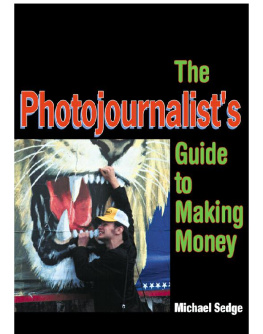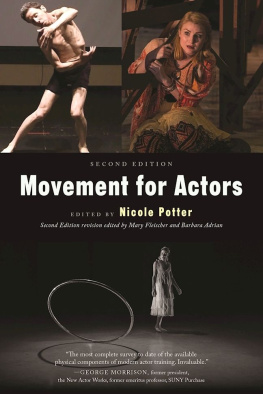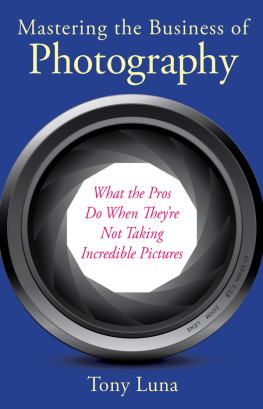
The Photojournalists Guide to Making Money
The Photojournalists Guide to Making Money
MICHAEL SEDGE
Foreword by Rohn Engh

2000 Michael H. Sedge
All rights reserved. Copyright under Berne Copyright Convention, Universal Copyright Convention, and Pan-American Copyright Convention. No part of this book may be reproduced, stored in a retrieval system, or transmitted in any form, or by any means, electronic, mechanical, photocopying, recording, or otherwise, without prior permission of the publisher.
05 04 03 02 01 00 5 4 3 2 1
Published by Allworth Press
An imprint of Allworth Communications
10 East 23rd Street, New York, NY 10010
Cover design by Douglas Design Associates, New York, NY
Page composition/typography by SR Desktop Services, Ridge, NY ISBN: 1-58115-076-8
Library of Congress Cataloging-in-Publication Data: XXXX Printed in Canada
Contents
Dedication
Early in my career, I established a small stock photo agency in southern Italy. Id like to dedicate this book to the photographers who had confidence in me and my dreams at that time: Ken Cole, Gerard Fritz, Norman Mosallem, Guido Picchetti, Ted Salois, Bob Schwartz, Robert Wickley, and lastbut actually the firstBob Zehring.
Among my happiest memories are writing commission checks for each of these talented professionals.
Foreword
by Rohn Engh
FOUNDER AND DIRECTOR, PHOTOSOURCE INTERNATIONAL
T o make money at anything, you need two elements: a good product and someone who wants to buy it.
Lets assume you have the firstthats the easy part (as youll learn in this book). Finding the second part is easy tooif you love what youre doing. If wild horses cant pull you away from photojournalism, you can succeed by following the tenets Michael Sedge puts forth in The Photojournalists Guide to Making Money.
Michael doesnt show you how to take effective photojournalistic pictures. You already know that. He shows you how to make a good living in a profession you love. The practical and power-packed insights that he shares with you are the fruits of his quarter-century of succeeding at his profession. You can be sure his path has included falling, picking himself up, and moving onward and upward. Michael shares these experiences with you and shows how to avoid pitfallsand also looks ahead at the portents for photojournalism as we all break ground in a new territorythe Internet.
Marketing, a word that has mushroomed in prominence in the last half century, has come to mean not selling, but placing your product convincingly to reach those who would be most receptive to buying it. This difference in emphasis is appealing to those in creative fields who find it difficult to hard-sell their work.
As a photojournalist, Michael Sedge clears many marketing barriers away for you, and effectively shows you how your photojournalism can be shared with millions and how you can make sure you are paid fairly for it. He shows you how to step off the treadmill of single sales, and instead multiply yourself, sliding into a world where your photographic efforts are rewarded twenty-and thirty-fold through the process of syndicating yourself.
Michael shows you how you can harness the World Wide Web to accelerate this process, making it possible for you to be in many places at the same time.
Photography is a universal language that is understood by everyone. No longer do you need to lease your photos and stories to single markets for fees that actually restrict your sales (because many markets cant afford them). He shows you techniques that he has developed, tested, and mastered over the years to get your product (yes, you are a producer of a product) out there and available to a worldwide audience.
Will you end up driving a Rolls Royce as a result of this book? Probably not. But you can learn how to be rewarded amply in a profession you enjoy, and live a satisfying life in the process. You have the choice of joining that rare category of people who truly enjoy their profession and would never choose to retire from it.
As a photojournalist, you are recording and commenting on life around you. Your photos and articles will not only serve to support you and your family, but serve as documentation for future generations. In a sense you become a historian commenting on the world as you see it. Eventually, your photos will go into archives that will become useful to future generations.
They will also serve as an annuity for you and your grandchildren. This brings to mind a friend, Flip Schulke, a photojournalist in the 1960s who captured the political turmoil of those times in the United States. In addition to photographing the demonstrations and strife that many other photographers were capturing, Flip sensed the significance of an emerging political figure, Dr. Martin Luther King, Jr. He looked deep into Dr. Kings life, befriended Dr. King and his family, and captured many intimate moments in their home life and informal vignettes, revealing the impact of the times on this family.
At first, Flips photos rarely interested photo buyers. The buyers were more interested in coverage of the riots, murders, and demonstrations. Not until twenty years later did Flip Schulkes photos begin to sell. Now they are featured on PBS specials, on CD-ROMs, in made-for-TV movies, and in museums and universities. Much of his photo coverage is available to students in colleges and high schools in the form of new media products.
Flip never envisioned that his interest in Dr. King and his family would still provide him with a stream of annual income nearly fifty years after he made his photographs.
This is onealbeit specialexample of what can happen as a result of your role as a commentator on and historian of your times. How do you measure success in the field of photojournalism? As in most creative fields, it cannot be measured by monetary gain, the size of your house, or the degrees you have acquired. A personal assessment can be the only measurement.
This book will help you forge your own directions. Photojournalism is not immune to the politics and hierarchies that usually develop in any professional community. Over the years, the field of photojournalism and the range of journalistic concerns have evoked almost a religious fervor among photographers and photography groups.
In this book youll encounter the many faces of photojournalism. They range from blue-collar, down-to-earth, no-name photographers, tramping around the globe, to elitist, holier-than-thou peacocks, protecting their territory.
Michael Sedge will show you the path. Your own ambition and persistence will lead you to your goals.
Its More Than Photography
T here are tens of thousands of individuals in the world today calling themselves photojournalists. But what exactly does that term mean? Is a portrait photographer a photojournalist? Is the travel writer who picks up extra cash with her camera a photojournalist? Is the photographer on assignment for Family Circle a photojournalist? Or is this an elite group peopled exclusively by hardcore news photographers like those employed by the Associated Press, Reuters, Newsweek, or one of the global stock agencies such as Blackstar, Gamma-Liaison, and Sygma?
Heres a paraphrase of what the editors of Websters New Word Dictionary consider to be a...
photojournalistn. a journalist who presents news stories mainly through photographs.
While I agree that most news photographers are, indeed, photojournalists, I disagree with the limitations that
Next page













